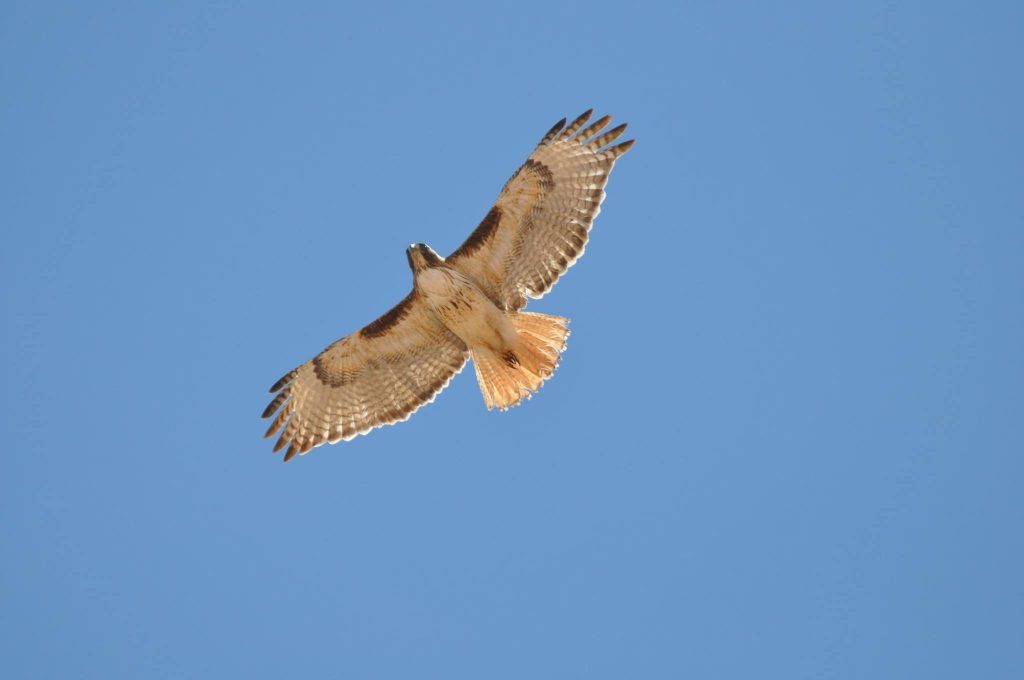The red-tailed hawk (Buteo jamaicensis) is one of North America’s larger raptors, weighing in between two and four pounds with a wingspan up to 56 inches. This bird of prey with the distinctive rust-colored tail is found in just about every type of open habitat on the continent.
Chances are there is a Red-Tail living near you. There is an estimated 2.3 million red-tails in the Western Hemisphere, with approximately 1.7 million spending some part of the year in the United States, 550,000 in Canada, and around 100,000 in Mexico.
Although the red-tailed hawk is not migratory, many northern birds will move south for the winter in pursuit of more abundant food sources.
The red-tailed hawk’s identifying features include the red tail that may, or may not have and a black terminal bar. Adults have dark brown plumage on their backs and the tops of their wings. The raptor’s underside is usually light with a dark belly band and a rusty tint on the chest and neck.
The red-tailed hawk’s eyesight is eight times more powerful than a human’s and can see colors in the ultraviolet range. While they are day hunters, they can see black and white well enough to hunt at dusk. The red-tail also has a nictitating membrane, a transparent inner lid that protects and cleans the eye in flight and while fighting its prey.
Most red-tail hawks hunt from a perch rather than soaring. Once the prey is detected, the hawk will launch from its perch, glide, and grab its meal from the ground with its talons. Their talons have a grip strength of 200 pounds per square inch. For context, the grip strength for an average 25-year-old male is 38-58 pounds per square inch and 26-41 pounds per square inch for a female.
A red-tail’s favorite food includes mice, rabbits, ground squirrels, quail, pheasants, snakes, and sometimes carrion.
Red-tail courting behavior starts in March and continues through May. Their aerial dating involves flying to great heights, then folding their wings and plummeting toward the ground, sometimes locking talons. Once paired, the red-tail will stay with its mate for life.
Red-tailed hawks build their nests in tops of tall trees or cliff ledges. In urban areas, their nests are often found on billboards and window ledges. Both male and female hawks build the nest using sticks, bark, and fresh vegetation. Once completed, the nest will average approximately three feet in diameter and up to six feet in height. Red-tails will often reuse nests from previous years.
Red-tail hawks will lay one to five eggs in two-day intervals. The eggs will incubate between 28 to 35 days. The chicks will hatch weighing two ounces and will stay in the nest approximately 45 days and with their parents for another one to two months.
While the red-tailed hawk has few predators, great horned owls and crows will prey on the hawk’s eggs and nestlings.
As the young hawks develop, they chase their parents for food with the adults dropping meals for the young birds to catch. As they get larger, the parents will drop live prey to teach the juveniles how to chase and catch.
Immature red-tails look similar to the adults with except the young bird’s tail is brown instead of red.
Red-tail hawks have been recorded living up to 25 years in the wild, although the average estimated lifespan is as low as six years. The primary causes of death are power line electrocution, shooting, eating poison bait set for other animals, and collisions with vehicles.
Do raptors a favor and don’t litter. Food that is discarded while driving attracts rodents to the edge of the road. The openness of the highway makes it a red-tail hawk’s easy, but risky rodent buffet.
Native Americans treasured the red-tailed hawk’s feathers, which were used in religious ceremonies and head gear. The red-tail is also frequently used in falconry due to their high level of trainability and social disposition.
